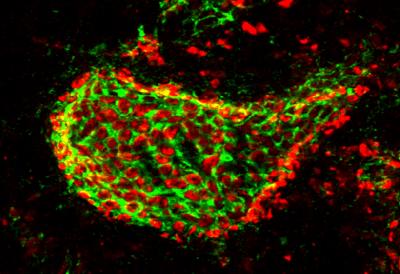More than a nice coating

A perineuronal net (in green) with synapses embedded in it (in red) Credit: Daniela Carulli
PERINEURONAL NETS INFLUENCE LEARNING
As the brain becomes older, the contacts between nerve cells (synapses) become less flexible, because they are encased in a meshwork of proteins and carbohydrates called a perineuronal net.
In the current study, researchers of the NIN (Verhaagen group and De Zeeuw group), in collaboration with the University of Turin and the University of Cambridge, induced a remarkable remodeling of cerebral synapses.
They improved the learning abilities of mice by using a powerful molecular tool to degrade the perineuronal nets. However, the capability of the mice to remember what they had learned was disturbed, indicating that the storage of acquired information requires intact perineuronal nets.
“This is the first time that it has been shown that changes in perineuronal nets are instrumental for motor learning and memory”, says Daniela Carulli, researcher at the NIN and first author of this study.
CHANGING OF PERINEURONAL NETS
Children have the capability to learn much better than adults, from mastering a new language to playing a musical instrument. This is possible thanks to the flexibility (or “plasticity”) of the connections between nerve cells in young brains.
Plasticity also allows a faster recovery from brain injury. “We discovered that perineuronal nets exert tight control on learning and memory in the adult brain”, explains Carulli.
The researchers investigated a well-characterized type of learning, called eyeblink conditioning, that depends on the cerebellum, a brain region involved in motor functions.
“Our results indicate that perineuronal nets are diminished during the learning phase of eyeblink conditioning, but are restored at later stages, when memories are consolidated”, Carulli continues.
Much still needs to be known as to how exactly perineuronal nets regulate plasticity, and, thereby cognitive functions. This is crucial in view of finding therapeutic strategies to tackle cognitive decline in the elderly or in patients with neurological disorders.
Media Contact
All latest news from the category: Health and Medicine
This subject area encompasses research and studies in the field of human medicine.
Among the wide-ranging list of topics covered here are anesthesiology, anatomy, surgery, human genetics, hygiene and environmental medicine, internal medicine, neurology, pharmacology, physiology, urology and dental medicine.
Newest articles

A universal framework for spatial biology
SpatialData is a freely accessible tool to unify and integrate data from different omics technologies accounting for spatial information, which can provide holistic insights into health and disease. Biological processes…

How complex biological processes arise
A $20 million grant from the U.S. National Science Foundation (NSF) will support the establishment and operation of the National Synthesis Center for Emergence in the Molecular and Cellular Sciences (NCEMS) at…

Airborne single-photon lidar system achieves high-resolution 3D imaging
Compact, low-power system opens doors for photon-efficient drone and satellite-based environmental monitoring and mapping. Researchers have developed a compact and lightweight single-photon airborne lidar system that can acquire high-resolution 3D…





















